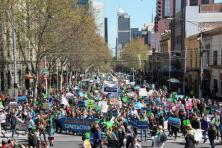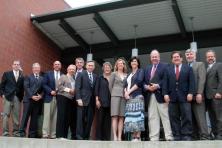In The New New Deal: The Hidden Story of Change in the Obama Era, Time reporter Michael Grunwald argues that the American Recovery and Reinvestment Act (the Recovery Act) has been an unsung success—in fact a historic law that kept the American economy from freefall. Grunwald also shines a light on how the Recovery Act initiated growth in a variety of new economic sectors, a prime example of which is efficient, clean energy.
Nationwide, the Recovery Act directed approximately $90 billion toward seeding a clean energy economy. As Grunwald points out, this unprecedented investment was over $80 billion more than former President Clinton had proposed unsuccessfully for a clean energy initiative in 1998. However, as Grunwald says, it was still just a “down payment” on the construction of America’s green economy—a small fraction of the whole American economy and, of course, pale in comparison to fossil fuel subsidies.
The success stories of the Recovery Act’s clean energy investment are visible across the country in numerous American cities. In our July 2012 report, Powering the New Energy Future from the Ground Up, the New Energy Cities team described the leadership of small- and medium-sized cities implementing projects in energy efficiency, renewable energy, smart grid and smart meter deployment, electric vehicles and other forms of clean transportation, as well as net-zero energy districts. The Recovery Act enabled much of this work.
Bainbridge Island and Bremerton, WA were among the 45 recipients of competitive Energy Efficiency and Conservation Block Grant (EECBG) grants from DOE, and have subsequently joined DOE’s Better Buildings partnership for residential energy efficiency. Bedford, NY, Charleston, SC, and Grand Rapids, MI are also Better Buildings partners, delivering energy efficiency results through creative community outreach and marketing.
Almost all of the cities profiled in our report used their EECBG formula funds—allocated to cities directly from DOE based on a population formula, or through states on a discretionary basis—to support their programs in some way. Thanks to EECBG, cities have implemented over 5,500 projects nationwide in municipal and community-wide energy efficiency, clean energy, sustainable transportation, and other measures to cut energy consumption and greenhouse gas emissions. Projects in smaller cities, such as zHome in Issaquah, WA, the nation’s first net-zero townhome development, used EECBG money administered by their county or state governments alongside private investment.
Many of the other cities in our Powering the New Energy Future report used other federal funds (such as the US Environmental Protection Agency’s Climate Showcase Communities grants, which were not part of the Recovery Act) as significant sources of program revenue. A smart grid grant from DOE was the critical anchor for the pioneering FortZED project in Fort Collins, CO. The City of Portland’s Solar America Cities award from DOE enabled expanded collaboration with communities in eastern Oregon such as Pendleton, known for the successful Solarize Pendleton program.
The Solar America Cities program (first started in 2007, subsequently supported by the Recovery Act, and now absorbed by the SunShot Initiative) was one of the more transformative federal programs in the clean energy space, engaging over 180 organizations, including municipal, county, and state agencies, solar companies, universities, utility companies, and nonprofit organizations, to power cities with clean, safe, and reliable solar energy. Local participants jointly committed to developing a sustainable solar infrastructure that removes market barriers and encourages the adoption of solar energy by residents and businesses.
The City of Knoxville, TN’s solar program was launched with support from the Solar America Cities program in 2008; the City later used its EECBG grant to fund the position of a sustainability director, who has been instrumental in executing the solar strategy. (A series of informative case studies on all of the Solar America Cities grantees are still available online here.)
Other programs helped cities start reinventing their transportation systems and built environments. Bellevue, WA and other cities in the Puget Sound have benefited from DOE’s Clean Cities investment in electric vehicles (EVs) and infrastructure, creating a new EV corridor that will be critical to support future market penetration in the region.
A diverse range of cities around the country received funding from the US Department of Transportation’s Transit Investments in Greenhouse Gas and Energy Reduction program—a total of $100 million nationwide for practical projects in fuel use reduction and operational efficiencies, prime candidates for saving taxpayer dollars.
Just last week, the DOE announced that one million homes had been weatherized or retrofitted under the Recovery Act. A range of Recovery Act programs enabled energy retrofits of affordable housing, helping families and landlords reduce their energy costs, as well as addressing a long-time issue of billions of public dollars wasted in energy costs. (Several weeks ago, we noted that the Rocky Mountain Institute is convening leading public housing agencies to tackle this issue, too.)
The Recovery Act also sparked creation of the Green and Healthy Homes Initiative, implemented in 15 cities around the country, in which homes will be inspected for health hazards before they are retrofitted for energy efficiency.
The Recovery Act’s influence of local government energy programs was not limited to funding—the most notable example being the Act’s requirement of states to adopt energy codes (with which localities would then have to comply) that met or exceeded the 2009 International Energy Code for residential buildings and ASHRAE 90.1-2007 for commercial buildings.
The Recovery Act has had lasting effects in less obvious ways: prompting federal officials to conduct joint grant reviews that integrate goals of transportation, housing, and sustainability (as in the Partnership for Sustainable Communities); rewarding cities that forged new partnerships with utilities, nonprofits, and foundations; and simply getting energy and sustainability on the radar of city officials around the country.
A question that all of us in the clean energy movement are working on now is how this work will live on in the absence of additional federal funding. Part of the job ahead involves what we at New Energy Cities do on a daily basis: identify and highlight the unsung and sometimes hidden stories of clean energy success in cities around the country. Scaling up these nascent successes to a national level remains the end game.



